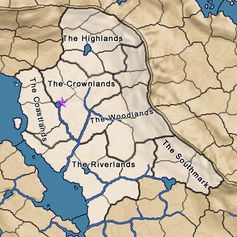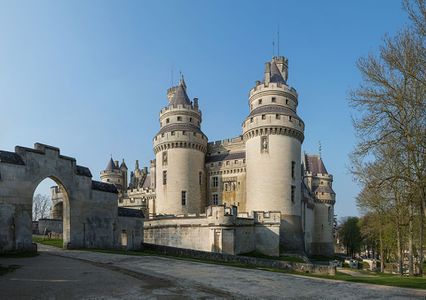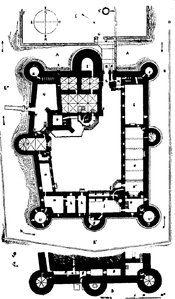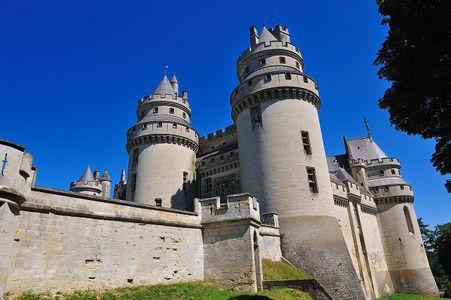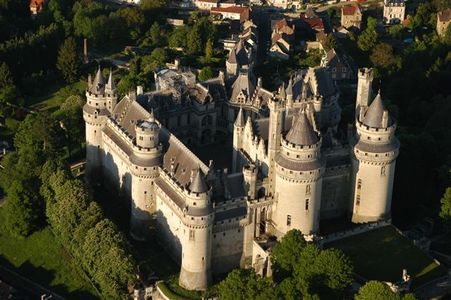Category:The Capital
| ||||||||||
|
| ||||||||||
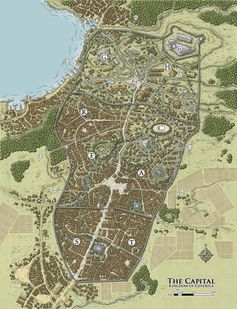 | ||||||||||
|
| ||||||||||
|
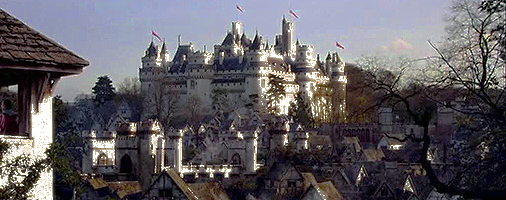
The Capital is the capital (!), and largest city of the Kingdom of Generica. It is located a bit to the west of the center of the kingdom, in the arldom of Brightcastle, on the eastern edge of King's Lake. Castle Royal, the seat of the Kingdom of Generica and site of the Old Throne, rests atop a hill at the northernmost point, overlooking the rest of the walled city. It enjoys a mild climate and life there is luxurious for those that can afford it, although it is not without its slums. The city is overpopulated and can be a little dangerous in spots, even in the best of times, despite being policed by a City Watch.
Contents
Tropes
Geography
- Kingslake, Crown River
- Kingswood
- King's Road
Origin and History
The Capital was founded by King Jon I. He established a small wooden fort atop the hill where his army first encamped, and used this as a base for his campaign to conquer the region. Having achieved his goal, he established the new castle on the site of his original fort. The city expanded rapidly under his descendants. By the time of the Black Army, the city had a population of approximately a hundred-thousand people.
Government
See Free City; Court of the Capital
Not technically a true "free city," answering directly to Castle Royal up the hill, but effectively so. The king may attend meetings in person, or through a representative—usually the Steward—at any time, should he so choose. The mayor serves as the council's liaison to/for the king, and has little real power of his own. As is usual, the City Council is populated almost exclusively by guild leaders, who, in this case, tend to think a little more highly of themselves than they ought due to their proximity to the king, and are often more concerned with their own betterment than the health of the city. The city is divided into eight districts, each subdivided into two wards. There are a total of sixteen eldermen forming the Small Council, of which one is the Mayor. The Great Council seats up to thirty-two.
The Capital is one of a handful of free cities granted "county status" in their charter, and as such, has a shariff, whose office is within Castle Royal.
Economy
- Hub of trade
- Fishing in the lake; lake feeds into the Crown River down to the Imperial sea
- Hub of roads; King's Road connects north and south
- HQ of many guilds
- Weekly Market Day on Thriday
- Annual Fair on the day before Midharvest Festival
Features
Castle Royal
Castle Royal is the seat of the royal court of Generica and ancestral home of the Crownroy dynasty. It is built on the site of the original hill-fort, and has been expanded greatly over the centuries—the Old Throne occupies the same spot it did 600 years ago. These days, it serves as a palace, more than a defensive fortification. The white stone walls of the castle tend to "shine" when the sun is high.
New City
Academics District (C)
The city district that houses the universities, colleges, and schools is referred to by two other names: the "Clerks' Quarter," as a reference to the students, tutors, scribes, and clerks who live here in great numbers; and "The Halls," meaning the large, airy buildings that typically house the schools. Though it is not apparent from outside the district, it is an area of plants, grassy yard, and small parks. It is second only to the Garden District in the number and variety of its greenery. The Millstream winds its way through the district, and much of its bank has been preserved as a grassy parkway. It is not a thriving "business" district—most of the buildings not used for schools are the residences of students and instructors.
Wards: Gardengate, University
Businesses: Art Galleries, Bakeries, Boarding Houses, Book Binderies, Butchers, Inksellers, Launders, Leatherworkers, Locksmiths, Potters, Private Libraries, Scribeshops, Tailors, Taverns, Tiny Food Shops, Weaponsmiths, and Weavers.
Common District (R)
AKA The Commons. This most riotous district is centered around the great curving avenue known as the Strip. With its taverns, brothels, gambling dens, and worse, the Strip at night is a cacophony of noises, a shadowland of flickering torches and blazing lamps. And always, day and night, it teems with drunks and toughs, boatmen and cityfolk. Naturally, adventurers love it here. Lodgings are cheap, and news from the world beyond is plentiful. There are numerous merchants and innkeepers willing to relieve a traveler of his heavy load of treasure.
Behind the Strip the district is a mixture of boarding houses and warehouses. While much cargo brought up the Crown River is stored on the wharf, many small warehouses are offered for rental here as well. Cargo moves quickly in the lively economy of the Capital, so a load generally remains in a warehouse only for a week or two.
Wards: Westgate
Businesses: Armorers, bakers, bawdy houses, boarding houses, boats/nautical equipment, boot maker/leatherworker, butchers, eateries, expedition suppliers, shipper and haulers, tailors, taverns, warehouses, and weaponsmiths.
Notable Locations:
- The Bawdy House
Foreign District (F)
This is the most crowded district of the New City, not just because this is the residential district assigned to all those who have not inherited or adopted Generic citizenry, but because it is a nice place to live. It offers a variety of eateries and taverns, as well as tiny shops of many unique types. Certain of the district's shops and inns retain a distinctive character reflecting their owners' origins. But for the most part this district has blended very well into the rest of the city's character. In many ways it is representative of the city in miniature, with its diversity of shops, its theatre (the Pit), and its mix of people from all places and all levels on the social scale.
It has long been city policy that visitors who take up residence in the Capital should not be allowed to inhabit certain areas, particularly places adjacent to the city wall. Thus, all foreigners who actually rent a residence (as opposed to taking a room in an inn, even for many weeks) must find such a residence in this district. Of course, foreign nobles and official guests of the city are exempt from the restriction. Foreigners are not permitted to purchase property in the city. After seven consecutive years of residence (at least six months each year) in the city, a foreigner can apply for citizenship. Provided he has two citizens to vouch for him, and no record of troubles with the watch or any influential guilds, citizenship is granted.
Wards: Burrowhill, Marshgate
Businesses: Every type of business can be found in this quarter. Problem is, though, if you asked someone where to find what you are looking for, half the time the directions are wrong.
Notable Locations:
- Burrow Hill, AKA Hobbit-Town
Garden District (G)
This district marks a great arc about the city's Noble District. In truth, an untutored observer could not tell where one district ends and the other begins. But the boundaries are clearly defined in the collective social consciousness of the city's elite.
If the estates there tend to be a little smaller than their uphill neighbors, if their statuary is less exquisite and the architecture more plain, these deficiencies are more than made up for by the brilliant profusion of blossoms grown here. The sweeping expanses of manicured beauty have given the quarter its name and its character. On a pleasant spring day the fragrance of lilac is carried by each passing breeze, while in summer a stroller can sample the dewy aroma of the lilies, and so on. There are no shops in the district, save for the region of the High Marketplace. Several fine inns and clubs offer fine cuisine and often gambling to wealthy patrons.
Wards: Wharfgate
Notable Locations:
- City Hall
- High Market
Noble District (H)
What a grand array of buildings and personages await the fortunate traveler who decides to stroll down the Promenade! What marvels of architecture! What splended grace and beauty, such impressive style! The grand edifices of the district are, in general, mansions that would be fit for the ruler of most political entities, but here, such homes are the just rewards for successful merchants, important ambassadors, the city's own councilmen, and others of wealth and station. The mansions sprawl over large estates—an equivalent amount of property might hold the homes of a thousand souls in the cramped confines of the Old City. Stores and shops are not found there; the residents can usually find everything they need at the city's High Marketplace. The only businesses in the districts are those gambling houses, taverns, and clubs that cater to a wealthy clientele.
The Noble District is the best illuminated of the city's districts after dark, for each mansion maintains a lamp on the road before it, and the city maintains other lamps at frequent intervals along each thoroughfare. In addition, the patrols of the city watch are diligent and common there.
The roads of the Noble District bustle with crowds only on the occasions of parades and festivals. The district receives a lot of traffic every Senday, attracted by the grand array of booths and stalls in the High Marketplace. Otherwise, the district is quiet, with only a few people moving about at any one time. These travelers are nobles in carriages, on horseback, and afoot, their servants (with or without their masters), craftsmen hired to work in the district on their way to and from the job, and many others. Travel is allowed to and from the district with no restrictions, but a visitor who appears to be up to no good (loitering about, acting furtive, associating with known criminals, etc.) is quickly accosted by a resident's guard patrol.
Wards: Kingsgate, St. Cudgel's
Notable Locations:
- Capital Cathedral (St. Prosylus' Cathedral of the Holy Pantheon); seat of the Archvicar of the Capital, Heirant Pompus
- Guildhall of Heroes; Heroes' Guild HQ
- Stagwood House
Trades District (A)
The Trades District is peaceful, lacking the wild taverns and crowds of most others. It is home to hardworking people and their families, and a great number of different businesses can be found there. While some of these artisans work for others and travel to a different location for their job, the majority work in shops within their homes. The major features of the district are the guildhalls, surrounded by small houses. At first glance one might think them crowded uncomfortably close together, but upon closer examination, the buildings all seem to fit snugly together while leaving a surprising amount of space between them. The hallmarks of each tradesperson can be seen on the front of the house: an ornately carved balcony and railing for the woodcarver, a wide, sweeping stairway for the carpenter, an imposing facade of granite for the stonemason, and so on. Weavers, painters, metalsmiths, and the like use an example of their craft to decorate the front of the house—a tapestry, unusual color scheme, or metal rack of tools, for example.
The district has its share of taverns, but these are quiet, neighborhood places. Most of the customers recognize each other and the proprietor—who is usually the owner. Strangers are treated cordially, but any unruliness arouses the resentment of the entire establishment. With its convenient location next to the Low Marketplace, the residents of this district rarely have to go elsewhere in the city for their needs. More than any other, the Trades District seems a self-sufficient community unto itself.
Businesses: Shipper and Haulers, Brewers, Leatherworkers, Weavers, Tailors, Metalsmiths, Jewelers, Gemcutters, Furniture Makers, Carpenters, Stonemasons, Architects, and Taverns with food
Wards: Vicarsgate, Blackgate
Notable Locations:
- Low Market
- St. Ferrus' Hall (Smiths' Guild)
Old City
This maze of alleys, shacks, boarding houses, and everything else is the true soul of the Capital. Herein lie the city's roots, and herein also live its most volatile citizens. The Old City, separated by the wall from the New City, has taken on a life all its own. If the New City should suddenly disappear from the earth, the Old City would function much as before. The same cannot be said for the reverse.
The Old City sees less of the City Watch than do its neighboring districts. Crime and misery are commonplace here, but so are gallantry and decency. The balance of power in the Old City centers on the Capitaline Thieves' Guild, which controls the major sources of income here, except for the Public Bath, which is owned by the city, though merchants and traders guilds are also well represented. The City Watch tends to be less active in the district.
West Side (S)
AKA Slum District
Wards: Southgate Within
East Side (T)
AKA Thieves' District (Trope: The City Narrows)
Wards: Bathhouse, Eastwall
Notable Locations
- The Old Locksmiths' Guildhall, seat of the Thieves' Guild
City Outskirts
The Spire
The Spire (outside town, just to the south, down the river); Wizards' Guild HQ
Barge End
Wards: Barge End Without
Shacktown
Wards: Southgate Without
The Wharves
Wards: Kingslake Without
Other Locations
Streets
- The Processional: main road bisecting the city from north to south, leading to Castle Royal
Squares
- Low Market
- High Market
Gates
Notable Institutions
- City Watch
- Crown Guard; the King's bodyguard-retinue
- Thieves' Guild of the Capital
- Capitaline (Martial) Guild of St. Virtus
- Capitaline (Shooters') Guild of St. Balisticus
Rumour Has It…
- Many believe there are secret tunnels and rooms in the sewers beneath the city, though nobody knows for whom or to what purpose they might have been built
Behind the Scenes
- Ripped off from D&D's "Free City of Greyhawk" (Ref2)
- Castle Royal "played by" Château de Pierrefonds, also used as "Camelot" in the TV series, Merlin
- The Capital is intended to be an equivalent to Tudor-era London in size and feel
- A lot like King's Landing in Game of Thrones, only the castle isn't against the ocean
- CK2: Considered a "fortress" (barony), though its castle-town is extensive/important enough to rival other proper "cities."
See Also
Subcategories
This category has the following 3 subcategories, out of 3 total.
Pages in category "The Capital"
The following 52 pages are in this category, out of 52 total.

